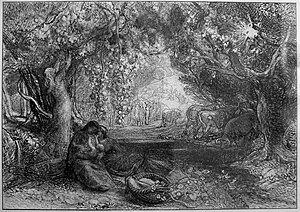
Eclogue 4, also known as the Fourth Eclogue, is the name of a Latin poem by the Roman poet Virgil. Part of his first major work, the Eclogues, the piece was written around 40 BC, during a time of brief stability following the Treaty of Brundisium; it was later published in and around the years 39–38 BC. The work describes the birth of a boy, a supposed savior, who once of age will become divine and eventually rule over the world. During late antiquity and the Middle Ages, a desire emerged to view Virgil as a virtuous pagan, and as such the early Christian theologian Lactantius, and St. Augustine—to varying degrees—reinterpreted the poem to be about the birth of Jesus Christ.
This belief persisted into the Medieval era, with many scholars arguing that Virgil not only prophesied Christ prior to his birth but also that he was a pre-Christian prophet. Dante Alighieri included Virgil as a main character in his Divine Comedy, and Michelangelo included the Cumaean Sibyl on the ceiling painting of the Sistine Chapel (a reference to the widespread belief that the Sibyl herself prophesied the birth of Christ, and Virgil used her prophecies to craft his poem). Modern scholars, such as Robin Nisbet, tend to eschew this interpretation, arguing that seemingly Judeo-Christian elements of the poem can be explained through means other than divine prophecy.
© MMXXIII Rich X Search. We shall prevail. All rights reserved. Rich X Search
